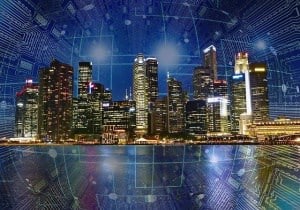The use of IoT technology at city-scale is becoming a rising trend, giving birth to a generation of modern areas known as “smart cities.”
In recent years, more and more countries have begun incorporating this technology into their infrastructures. So far, IoT has been used to elevate crucial systems that affect citizens’ daily lives, such as healthcare, public transportation, workplace, waste management, and energy distribution.
According to a market report from Grand View Research, the market size of smart cities is expected to reach US$676.01 billion by 2028. In the era of advanced IoT and LoRaWAN technology, the possibilities for improving the way we live and interact with each other in cities is endless
First, what is a smart city?
By definition, it's a technologically modern urban area that uses different types of electronic methods, voice activation methods, and/or sensors to collect specific data. This data is then used within the framework put in place along with other technologies such as IoT to develop, deploy, and promote sustainable development practices and address the needs accompanied by urbanization.
What technology makes up a smart city?
This framework is made up of a network of connected objects and machines that help transmit data using wireless technology, such as LoRaWAN and the cloud. IoT comes in as the mediator between these objects and will help citizens engage with the systems created by using devices such as smartphones, tablets, cars, and even homes. Examples of this technology working within the city framework include:
- Air Quality. A growing concern in most major cities, smart cities are now equipping new technologies to monitor pollution, dust, and air particles to better inform residents in real-time of the current levels of pollution in the air.
- Waste Management. IoT systems are used to help optimise the efficiency of collection and reduce operational costs while also addressing environmental issues associated with inefficient waste management. Smart sensors are also used to send signals when trash containers are full will help ensure that collectors come only when it is essential.
- Smart Infrastructure: These infrastructures often include automated lighting, smart elevators, and more, buildings and homes are able to learn from their environment to become more energy-efficient and reduce excessive power usage.
- Traffic Management. IoT is making it much simpler to optimize traffic patterns. Using sensors to track and send real-time updates about traffic flow to a management platform, the system can analyse and adjust traffic lights and so on to the current situation in just seconds, with little to no human supervision.
Two successful smart city applications
A small number of smart cities around the world are already leagues ahead and exist already, two of which are in the APAC region. Both Hong Kong and Singapore are great examples of smart city adoption:
1. Hong Kong. In 2019, then Hong Kong’s Secretary for Innovation and Technology Nicholas Yang announced plans to push for smart city construction, in line with the Hong Kong Smart City Blueprint that was released in 2017. With over 70 initiatives included in the plan, one feature has become most pervasive in the city: smart lamp posts. Fitted with sensors, these multifunctional lampposts serve as bases for measuring traffic conditions, monitoring weather and air quality, and tracking illegal waste dumping, among others. In April 2020, Hong Kong also commercially launched 5G technology that enabled breakneck Internet speeds. And most recently in April 2021, China Mobile Hong Kong (CMHK) became the first local operator to provide 5G services for the Hong Kong International Airport.
2. Singapore. Their Smart Nation program was launched back in 2014 by Prime Minister Lee Hsien Loong. Through sensors and cameras deployed all throughout the island, Singapore has collected an unprecedented amount of data on daily life in the city. This has allowed them to monitor how the nation is functioning in real-time closely. Their transport networks, for example, make use of road sensors, smart parking, and phased traffic lights to improve traffic flow and solve congestion problems.



